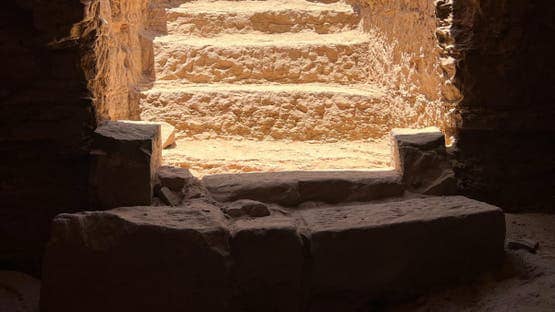Discovery of Archaeological Tombs Dating Back to the Greek and Roman Eras in Aswan as Part of an Egyptian-Italian Mission

The joint Egyptian-Italian archaeological mission, between the Supreme Council of Antiquities and the University of Milan, succeeded in uncovering a group of rock-hewn tombs dating back to the Greek and Roman eras during the current excavation season in the area surrounding the Agha Khan Mausoleum west of Aswan.
Tomb of Ka-Mesu: Distinctive Design and Archaeological Treasures
Tomb No. 38 represents one of the most prominent discoveries this year due to its distinctive architectural design and good construction condition. This tomb lies more than two meters below the ground surface and can be accessed via a stone staircase composed of nine steps surrounded by brick platforms used for offerings.
At the heart of the tomb, the team found a large limestone sarcophagus two meters high, placed on a rock platform carved into the mountain. The attention is drawn to the sarcophagus lid sculpted in a highly accurate human form, displaying clear facial features adorned with a wig and various decorations. The hieroglyphic inscriptions on the sarcophagus revealed prayers directed to the local gods in Aswan, along with the name of the tomb owner "Ka-Mesu" who held a high position in his time, along with mention of his family members.
New Insights into Social History
Egyptian Minister of Tourism and Antiquities, Khaled El-Enany, expressed his pride in this discovery, which he described as a "qualitative addition," emphasizing that it sheds light on the richness and diversity of ancient Egyptian civilization. He also praised the international scientific cooperation that contributed to this achievement, noting that these tombs offer new insights into understanding social life in Aswan during the Ptolemaic and Roman eras.
Dr. Mohamed Ismail Khalid, Secretary-General of the Supreme Council of Antiquities, explained that the discovery confirms the continuous use of the area as a cemetery by various social classes, where the elite were buried in the upper tombs while the middle class settled on the slopes.
He added that the inscriptions and archaeological finds discovered will be a rich source for researchers in the field of Egyptology, especially in studying funerary traditions and religious symbols during the later periods of ancient Egyptian history.
Future Studies on Mummies
Officials revealed plans to study the discovered mummies, including those of children, using CT scans and biological analyses during the upcoming autumn season. These studies are expected to reveal important information about the identities of individuals, their life conditions, and deaths.
Layers of History in Aswan Necropolis
Mohamed Abdel-Badea, Head of the Egyptian Antiquities Sector, pointed out that the top of the hill contains huge tombs dating back to the Ptolemaic era, originally designated for the families of the wealthy elite before being reused in the Roman era.
It is worth mentioning that in previous seasons, the mission had uncovered funerary platforms and rock-cut tombs in the mountains of Sidi Uthman, revealing unique architectural patterns reflecting how humans adapted to the surrounding environment.
Continuation of Archaeological Work
The archaeological mission has been working at the site since 2019 under the leadership of Dr. Patrizia Piacentini, Professor of Egyptology at the University of Milan, and Prof. Fahmi El-Amin, General Director of Aswan Antiquities. The successive discoveries in the Agha Khan Mausoleum Necropolis highlight the great archaeological value of the area, enhancing its status as one of the most important historical sites in southern Egypt.